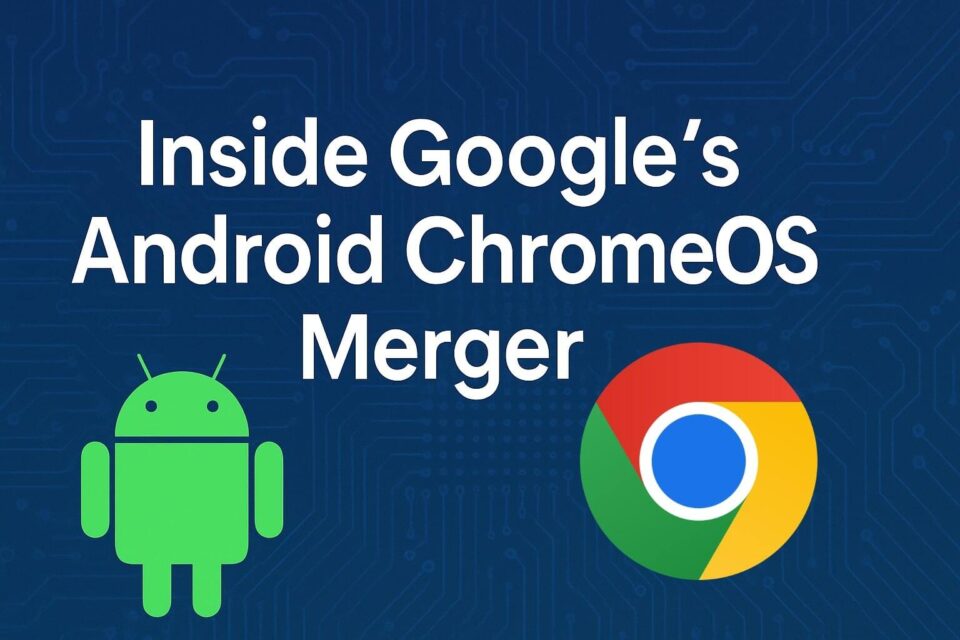“We’re going to be combining ChromeOS and Android into a single platform,” says Sameer Samat, President of Google’s Android Ecosystem.
It’s official – After speculating for years, Google has officially announced the merger of Android and ChromeOS into a single unified platform, allowing Google to better compete with Apple’s ecosystem
Samat revealed this change in a recent interview which marked a significant shift in Google’s software direction. The Android ChromeOS merger represents a major strategic change for Google which aims to create unified user experiences across devices while making development easier for both Google and its partners.
The official announcement about Android ChromeOS merger has just been made although Google started merging Android kernel components into ChromeOS during the first months of 2024.
Why This Merger Matters
This shift is driven by both strategic and practical considerations. Android ChromeOS Merger enables Google to provide users with a unified interface and application experience that works across phones, tablets, laptops and foldables.
Android ChromeOS merger also simplifies internal development. Google can now focus its engineering resources on a single unified operating system instead of maintaining two separate systems. The unified system enables quicker software updates and wider feature deployment and a unified software environment. The Android ChromeOS merger works to enhance system compatibility while unifying the company’s product range.
Key Features in Development
The foundation for this transition has been in motion for some time. ChromeOS already shares the Linux kernel and several components with Android. Now, Google is speeding up this merger by testing Android’s desktop mode, which introduces features such as windowing tools, multi-window multitasking, and external display support.
Another major feature in testing is Linux terminal support, a key addition for developers and advanced users. The reports also indicate that Google is working on a Pixel-branded laptop that will run this new Android-based desktop interface which is codenamed “Snowy” and will be the first device to show the merged OS experience.
Strategic Advantages for Google
The Android ChromeOS merger is more than a technical move. It aligns with Google’s larger strategic goals. The first point establishes Android as the fundamental operating system which runs across all product types including smartphones and desktops.
Second, it enhances Google’s AI ambitions. The unified Android base provides better opportunities to integrate Gemini-powered AI features into Chromebooks and tablets which enables smarter productivity tools and voice assistants and adaptive experiences.
Finally, with move Google will be better place to compete with Apple in the tablet and laptop market. By blending ChromeOS’s productivity strengths with Android’s app ecosystem, Google may finally bridge the gap.
What Users and Developers Can Expect
For users, the biggest advantage is a seamless, cross-device experience. A single operating system enables users to experience identical features and settings and applications across their phone and tablet and laptops, with better application compatibility on bigger screens and enhanced external display functionality.
The merger of the operating systems decreases the number of different platforms that developers need to support. Developers can now use a standardized toolchain and tap into a larger user base because they no longer need to create separate versions for two different systems. The inclusion of Chromebook users in Android’s reach makes the platform more appealing to developers for app development.
Open Questions and Challenges
However, there are still some uncertainties, even though Google’s direction is clear. ChromeOS is known for its automatic updates and strong security protocols. It is yet to be confirmed if these benefits will carry over to an Android-based desktop environment.
It is also uncertain whether the Android desktop experience can match the maturity and simplicity of ChromeOS, or whether it will feel like a stretched mobile UI. User feedback during testing phases will likely shape how these concerns are addressed.
What’s Next?
The official timeline remains unknown yet and the implementation process will extend over time. Google may reveal more about the merger at future product events. For now, the process remains in its initial phase. The delayed Chromebook release cycle in 2025 indicates that the company is making preparations for a significant behind-the-scenes transformation.
The Android ChromeOS merger marks a significant move by Google to unify its software systems while strengthening its artificial intelligence features and device connectivity capabilities.
Frequently Asked Questions (FAQs)
What is the Android–ChromeOS merger?
The Android–ChromeOS merger is Google’s initiative to unify its two operating systems—Android (for mobile) and ChromeOS (for laptops and tablets)—into a more seamless, integrated platform for users and developers alike.
Why is Google merging Android and ChromeOS?
Google is merging Android and ChromeOS to create a unified experience across devices, simplify development, boost ecosystem compatibility, and better compete with Apple’s iOS/macOS integration.
How will this merger affect Android and ChromeOS users?
Users can expect faster performance, shared app support, improved syncing, and a consistent interface across phones, tablets, and Chromebooks.
Will Android apps work on the new merged OS?
Yes, the goal is to make all existing Android apps compatible with the unified platform, while also bringing improved functionality to Chromebooks.
When will the Android–ChromeOS unified OS launch?
While Google hasn’t announced an exact release date, developer previews are expected to roll out in late 2025, with broader availability in 2026.
Is the new OS more secure than Android or ChromeOS?
Google has hinted that the new OS will integrate advanced security features from both Android and ChromeOS, offering more robust protection, sandboxing, and regular updates.
Who benefits the most from this merger?
Developers will benefit from a single codebase, while users enjoy a consistent experience across all their devices—whether they’re working, gaming, or learning.

